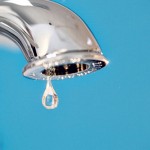Drip. Drip. Drip. Not only can the sound of an incessantly dripping faucet irritate you, but it can also serve as a telltale sign of precious resources going down the drain. But the most frequent plumbing problem, a leaky faucet, is also the one of the easiest to repair. The experts at Nano Tek-On say the most common culprit is calcium and lime scale buildup. For simple fixes, follow these steps:
First, turn off the water supply. The shutoff valve is usually under the sink. You’ll also want to follow this by turning the faucet on before proceeding to allow the water left in the pipes to drain. Next, prepare the area. Make sure to close the sink drain and cover it to prevent dropped parts from going down. Determine where the leak is coming from, and start there.
If it’s coming out of the handle, you’ll need to remove the handle assembly. Pry off the decorative cap and unscrew the set screw underneath. Then, lift off the handle. Tighten the valve first to see if this solves the problem. If it does-n’t, remove it and examine the area below. Clean any buildup you see in the threads. Use distilled white vinegar and a scouring pad.
If the source of the leak is at the base of the faucet, this is where you’ll start. Take masking or duct tape and wrap the jaws of your pliers. This prevents your pliers from scratching the fixture. Twist off the base with your wrapped pliers, and again, look for buildup and clean if necessary.
Another problem may be damaged O-rings. With your faucet disassembled, take a close look at the O-rings. If they look deteriorated or torn at all, replace them.
Seal with plumber’s putty before putting them back on, and make sure to tighten the handles. After all, loose handles can also create leaks.
There are many types of faucets. Determine your type and refer to your manufacturer’s manual before starting any repair work. Many faucets also come with a repair kit, which should contain O-rings and other items you may need.

